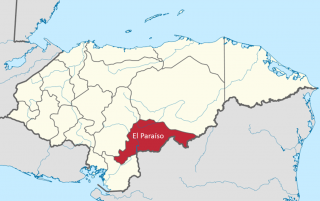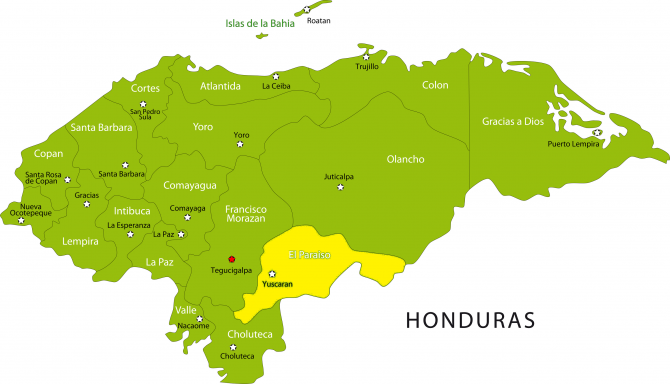El Obraje, Honduras
![]()
![]()
![]()
![]()
![]()
![]()
![]() Click on Programs to learn more about their work in this community
Click on Programs to learn more about their work in this community
General Information

| Population* | 1283 |
| Number of homes | 305 |
| Avg # of people per home | 4.2 |
| Electricity | Yes |
| GPS |
N 14° 00.080’ W 086° 26.169’ |
| Altitude | N/A |
| Municipality | El Paraiso |
| Department | El Paraiso |
| Corresponding Health Center | CESAMO-Jutiapa |
| Distance from compounds | 2 hours |
| Road conditions | Good |
* Population does not reflect how many patients will be seen on medical
brigades as many people from surrounding communities come seeking
Medical Brigades medical attention.
Top Three Needs Expressed
The top needs expressed by the key community members are the repair of school buildings, the formation of a waste management system, construction of a perforated well water system, and increased protection for the water source.

El Obraje is located in the Danlí municipality of the El Paraíso department.
El Obraje’s educational system includes Kinder, Primary, and Middle schools (until 9th grade), led by school director Alejandro Alberto Flores. There are approximately 423 students total. It is estimated that about 80% of the community knows how to read and write.
El Obraje has a water system that was built by the government in 1980 and was renovated in 2000. The water source has been drying up for years now because the owner of the land where the water source is located has not been taking care of the watershed (i.e. has not been protecting the trees around the source). Water is available every other day, but the community is concerned about the future of their water situation and would like to create a perforated well. Currently, the water is not being chlorinated1 because they do not have a hypo-chlorinator. Homes were equipped with Biosand filters for water treatment, but there are only 15 homes that still have functioning filters that they regularly use. Originally, when the community did chlorinate, there were some complaints about the smell and taste of the water. Almost 100% of the community is connected to the water system, and there is a Water Council made up of 7 active members with Matías Tercero as the Water Council contact.
El Obraje does not have a Health Center in the community. The nearest health center is in Jutiapa which is located about 40 minutes walking distance. There is no access to dental care. While there is no community health committee, there are local midwives trained by ASHONPLAFA.
The most common illnesses seen by community members are the common cold and skin fungus. Approximately 98% of the community has latrines that currently function. 0-10% has eco-stoves (estufas justas) and 65% is estimated to have concrete floors.
Though there is no health data available at the community level for El Obraje, below are some available health center statistics from the CESAMO-Jutiapa2 that serves El Obraje:
Caserios (small villages) served by CESAMO-Jutiapa, 2009
|
Caserios |
Population |
Number of Homes |
Potable Water (%) |
Latrines (%) |
Malnourished Children |
Births/ % Coverage of Pregnancies |
Order of Priority (based on HC standards) |
|
JUTIAPA* |
3673 |
900 |
98 |
100 |
NA |
78 / 62% |
14 |
|
Obraje* |
1283 |
305 |
100 |
100 |
NA |
30 / 46% |
12 |
|
Coyolar |
532 |
130 |
100 |
100 |
NA |
13 / 56% |
9 |
|
Gualiqueme |
407 |
115 |
100 |
100 |
NA |
10 / 83% |
8 |
|
Santa Ana |
482 |
95 |
100 |
100 |
NA |
3 / 20% |
7 |
|
Hatillo |
191 |
30 |
100 |
100 |
NA |
3 / 100% |
1 |
|
Habillal |
262 |
50 |
100 |
100 |
NA |
7 / 58% |
13 |
|
Crucitas |
315 |
72 |
100 |
100 |
NA |
11 / 52% |
11 |
|
La Campo |
401 |
66 |
100 |
100 |
NA |
12 / 52% |
10 |
|
Los Guasimo |
287 |
44 |
100 |
100 |
NA |
2 / 17% |
4 |
|
19 Abril |
172 |
30 |
100 |
100 |
NA |
3 / 50% |
6 |
|
Bienvenidos |
211 |
65 |
100 |
100 |
NA |
4 / 50% |
5 |
|
Minas |
105 |
19 |
100 |
100 |
NA |
0 / 0% |
2 |
|
Perceverante |
110 |
39 |
100 |
100 |
NA |
0 / 0% |
3 |
Centro de Salud Statistics, Centro de Salud Regional-Danlí, 14 Marzo 2010
*Global Brigades also works in these communities with medical brigades.
(NA) = Not available data
The average family income per month is estimated to be 2000 Lempiras, which is approximately L400 (US $21.18) per person3. The majority of homes are made of adobe, though many also have block and brick. The main form of employment in El Obraje is agriculture on rented and owned land, and the main products that are cultivated are corn, beans, and cornmeal (maizilla). El Obraje has a community cooperative made up of 36 members that gives small agricultural loans and was trained by ACAN (National Campesino Association) and a Swiss cooperative in 1999. There is also a women campesino association (FEMUC) that needs further training. Agricultural land owners also have access to the national agriculture cooperative BANADESA in Danlí. The community is also interested in forming a community bank for those who do not own land or work in agriculture.
El Obraje has received medical brigades from the Program for Area Development (PDA) by World Vision, however this is exclusively for kids who are sponsored through their program. PDA is also providing a nutritional lunch program for kids in the school system. ALA 8620 and FORCUENCAS have helped with water access in nearby villages, alleviating some of the water burden on El Obraje.
Check back soon for photos!
Source of information: Key informant interview, Health Center statistics
Date of interview: 16 March 2010
1The accepted regulation frequency for chlorinating water is every 4 days.
2CESAMO and CESAR are terms used for types of health centers. CESAMOs are larger, more comprehensive facilities that usually have a physician on staff at all times and occasionally a dentist. CESARs are more remote, less equipped facilities, usually with 1-2 nurses on staff.
3According to Red Solidaria and World Food Programme in Honduras, the average family is approximated at 5 people per household, the poverty line is L930 (US$49.23) per person per month, and the extreme poverty line is L617 (US$32.66) per person per month.